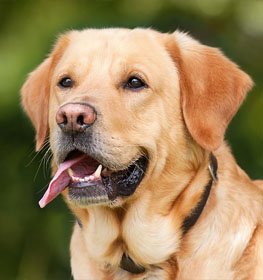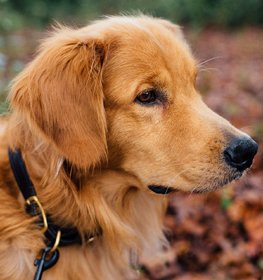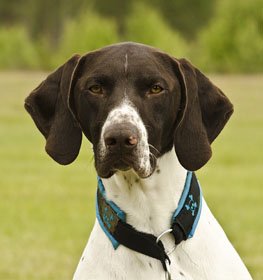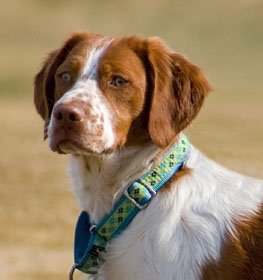Small Munsterlander Information & Dog Breed Facts
Collection of all the general dog breed info about Small Munsterlander so you can get to know the breed more.
| Group | Gun Dog |
|---|---|
| Popularity Rank | 198 |
| Reviews | 2 |
| User Ratings | |
|
Compare the Small Munsterlander With Other Dogs
Select at least one dog breed to make the comparsion. | |
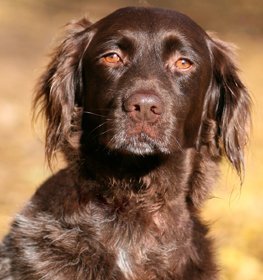 | |
| Origin | |
|
Common Names & Aliases
What other names is a Small Munsterlander known by? Discover all traditional, regional and informal names used for this breed. | HeidewachtelMunsterMunsterlanderSmall MunsterlanderSpionVorstehhundKleiner Münsterländer |
|---|---|
|
Breed Classification
What type of dog breed is a Small Munsterlander? Learn about its genetic classification and breeding category. | Purebred |
|
Size Classification
What size category is a Small Munsterlander? Learn how big the Small Munsterlander breed typically grows. | Medium |
|---|---|
|
Weight Statistics
How much does a Small Munsterlander weigh? Discover typical weight ranges for adult males and females of the Small Munsterlander breed. | Male: 45–60 pounds (20–27 kg), Female: 35–50 pounds (16–23 kg) |
|
Average Weight
What is the average weight of a Small Munsterlander? | Male: 52.5 pounds (24.5 kg), Female: 45 pounds (20.5 kg) |
|
Height
How tall is the Small Munsterlander? Small Munsterlander height: | Male: 20–22 inches (50–56 cm), Female: 19–21 inches (48–54 cm) |
|
Average Height
What is the average height of a Small Munsterlander? | Male: 21.5 inches (56.5 cm), Female: 20.5 inches (53.5 cm) |
|
Price Range
How much does a Small Munsterlander puppy cost? Find current market prices and factors affecting Small Munsterlander costs. | $800-$1000 If you choose to purchase the Small Munsterlander, you should know that the mentioned amount of money is an average of the collected data from breeders’ sites and puppy finder places. If you have a Small Munsterlander for sale, please advertise it on a reliable website to make sure the Small Munsterlander gets to a happy place. |
|---|---|
|
Availability
How easy is it to get a Small Munsterlander? How many Small Munsterlander are there in the world? | Frequent: The Small Munsterlander is easier than average to get. Maybe there is some risk of overbreeding, as it is a popular breed. Due to its popularity, inbreeding may occur. A new study shows that inbreeding contributes to the incidence of disease and health problems. So be careful and seek the help of an experienced person or a professional, in making your decision. |
|
Intelligence Rating
How intelligent is a Small Munsterlander? Discover the Small Munsterlander's intelligence ranking and learning capabilities. | Average: It takes patience to teach this breed any tricks or commands, but the effort is worth it. They understand and remember new commands after an average of 25-40 repetitions.
The Small Munsterlander ranks average in the intelligence ranking of dogs. |
|---|---|
|
Training Difficulty
How easy is it to train a Small Munsterlander? Learn about the Small Munsterlander's trainability and response to training methods. | Small Munsterlander dogs are very easy to train. They easily find out the association between commands and actions. |
|
Watchdog Rating
How good is a Small Munsterlander as a watchdog? Learn about the Small Munsterlander's alertness and guarding instincts. | Small Munsterlander dogs are average watchdogs. If they sense something different, they will alert you, but observation isn't considered their main job.
|
|
Territorial Protection
Is a Small Munsterlander protective of its territory? Learn about the Small Munsterlander's guarding instincts and behavior. | Small Munsterlander dogs strongly protect their territory. This breed is a complete security guard, so you don't have to be afraid in case of danger. |
|
Personality Traits
What personality does a Small Munsterlander have? Learn about characteristic Small Munsterlander temperament and behavior traits. | HappyIntelligentAffectionateStrongWilledAttentiveTrainable |
|---|---|
|
Sensitivity Level
How sensitive are they? Small Munsterlander sensitivity: | Sensitive: Small Munsterlander dogs don't like an irregular daily routine, noisy household, and frequent guest visits.
This breed's emotional level reflects their owner's feelings and they don't handle punishments well. |
|
Affection Level
How affectionate are they? Is a Small Munsterlander a good family dog? | High: Small Munsterlander dogs are genuinely loyal, soft and gentle, loving, and affectionate dogs toward their handlers. They enjoy quality time with their owners despite the activity and are considered great therapy dogs for those in need. This breed responds strongly to their handler's emotions because they bond closely. Their happiness is your happiness. |
|
Social Needs
How much social interaction does the Heidewachtel need? Small Munsterlander social needs: | Small Munsterlander dogs are a social breed. They enjoy being around people or other animals. This breed doesn't tolerate being left alone. |
|
Impulse to Wander or Roam
How likely is the Small Munsterlander to run away? Does this breed explore or wander a lot? Does Small Munsterlander roam? | The wanderlust potential of the Small Munsterlander is strong enough to escape from home. They have a strong desire for exploring the world. Safer to walk them on a leash unless you teach them how to get back to you on command. |
|
Prey Drive
Do this canine have a strong prey drive? Does Small Munsterlander have high prey drive? | Small Munsterlander dogs have an average prey drive, which means that they don't have a high impulse to chase and catch something like a cat or any other small aminals, but it might happen. Training can help to achieve good behavior. |
|
Barking Frequency
Does a Small Munsterlander bark a lot? Learn about typical Small Munsterlander vocalization patterns and triggers. | Average: The Small Munsterlander barks occasionally. They can change their barks depending on their emotional level and what they're trying to say. Different barks could mean the same and the same barks could have different meanings.
Top reasons for barking: protection, alarm, fear, boredom, attention-seeking, greeting, separation anxiety, compulsive barking. |
|---|---|
|
Playful Nature
How playful is a Small Munsterlander? Understand the typical play drive and energy level of the Small Munsterlander breed. | The Small Munsterlander is a playful breed. Excited barking and sometimes nipping will alert you to play. |
|
Apartment Adaptability
Can a Small Munsterlander live in an apartment? Learn about the Small Munsterlander's suitability for apartment living. | Not an apartment-friendly dog the Small Munsterlander breed. If you don't have a garden, think carefully about your decision, keeping Small Munsterlander indoors can cause a lot of problems. |
|
Lifestyle Adaptability
How adaptable is a Small Munsterlander to lifestyle changes? Learn about the Small Munsterlander's flexibility to new situations. | Small Munsterlander dogs adapt very well to lifestyle changes and basically all living environments. They don't mind moving from one place to another with their owner. |
|---|---|
|
Alone Time Tolerance
Can a Small Munsterlander be left alone? Learn about the Small Munsterlander's tolerance to solitude. | Small Munsterlander dogs do best when a family member is at home during the day or if their workplace is dog-friendly so they can take the dog at work. |
|
Bite Risk Assessment
What is a Small Munsterlander biting potential? Learn about the Small Munsterlander's bite risk factors. | Low 🔽 The Small Munsterlander has a low chance of biting somebody. Top reasons for dog bite: protection, pain, excitement, herding instinct, being provoked. (Data based on the available online bite statistics.) |
|---|---|
|
Mouthing Tendency
Is a Small Munsterlander mouthy? Learn about the Small Munsterlander's tendency to use mouth during play. | Small Munsterlander dogs have a higher than average tendency to nip, chew, playbite, or herd people. It's a common habit during puppyhood, not aggressive behavior. These "bites" don't hurt, but Small Munsterlander dogs need to be taught a good attitude. |
|
Bite Strength Rating
How strong is a Small Munsterlander bite? Learn about the Small Munsterlander's bite force measured in PSI. | Between 200 and 400 PSI ⏺ Small Munsterlander bite force: Ordinary. Bite force Small Munsterlander measurements typically fall within the range of 200 to 400 PSI. The bite force of a Small Munsterlander is considered ordinary when compared to other dog breeds, but it is still quite powerful. This Small Munsterlander bite force PSI can cause bite wounds. Small Munsterlander bite PSI is not something that should be feared if the dog is well-trained and managed. To avoid any issues, it's essential to learn how to train a Small Munsterlander puppy not to bite from an early age.
The Small Munsterlander, and many others, have a fearsome presence because they have significant jaw strength, so it is important not to anger the dog and have it around strangers until it is fully trained. However, they are usually quite calm and good companions, they work well in families and are easy to care for. In conclusion, while the Small Munsterlander bite force is certainly an interesting aspect of the breed, it is important not to let it overshadow the many other reasons why these dogs are so loved and respected. With proper training and socialization, a Small Munsterlander can be a loyal and protective companion for your family. |
|
Average Lifespan
How long does a Small Munsterlander live? Learn about the typical lifespan of the Small Munsterlander breed. | 12-14 years The average lifespan of Small Munsterlander: 13 years |
|---|---|
|
Climate Tolerance
How well does a Small Munsterlander handle different weather? Learn about the Small Munsterlander's climate adaptability. | Tolerates warm and cold weather Dogs that tolerate hot and cold weather are typically those that have a double coat of fur. Dogs with a double coat of fur have a layer of fur that insulates their skin and helps protect them from the cold and the heat. |
|
Health Concerns
What health issues are common in a Small Munsterlander? Discover typical conditions affecting the Small Munsterlander breed. | Small Munsterlanders tend to have more frequent health issues than other breeds. Regular vet check-ups are needed.
|
|
Vet Care Frequency
How often does a Small Munsterlander need vet visits? Learn about the Small Munsterlander's veterinary care requirements. | Frequent The Small Munsterlander should have a complete physical check-up at least once (but preferably twice) per year. If your dog shows any symptoms, call your veterinarian. |
|
Health Problems
What genetic/health problems does the Small Munsterlander breed have? What are the health issues and concerns of the Small Munsterlander breed? Most common health risks of Small Munsterlander: | Hip Dysplasia Skin IrritationEar InfectionsVision Problems |
|
Energy Rating
How energetic is a Small Munsterlander? Understand daily activity needs of the Small Munsterlander breed. | Small Munsterlander dogs are high-energy dogs. An active lifestyle makes them happy. |
|---|---|
|
Activity Requirement / Exercise Need
How much exercise does a Small Munsterlander need? How much exercise do Small Munsterlander dogs require per day?
Do Small Munsterlander dogs need a lot of exercises? | Small Munsterlander dogs need a lot of exercises. Long walks should be on a daily schedule. If you live an active life, this breed can be a good choice for you. |
|
Sleeping Need
How much sleep does the Small Munsterlander breed need? | Small Munsterlander dogs don't need too much sleep. They are energetic and desire to live active life. If you think naps are overrated, this breed can be the best choice for you. |
|
Obesity Tendency
Is a Small Munsterlander prone to weight gain? Learn about the Small Munsterlander's obesity risks. | Average: The Small Munsterlander has an average risk for obesity. Daily walks should be on schedule. To make your dog happy and fit, feed him with quality dry dog food and live an active life together. Try to find the happy medium between exercise and feeding.
If you notice any weight gain, consult your veterinarian and make a diet plan. Reduce unhealthy food and snacks, and measure the Small Munsterlander weight regularly. |
|---|---|
|
Food Consumption
How much food does a Small Munsterlander need daily? Learn about the Small Munsterlander's feeding requirements. | 1.5 to 2.5 cups of high-quality dry food a day, divided into two meals. |
|
Allergy Friendliness
Is a Small Munsterlander hypoallergenic? Learn about the Small Munsterlander's suitability for allergy sufferers. | No Small Munsterlander dogs don't do well with allergy sufferers by causing allergic reactions. Some dog breeds are even considered to higher possibility of an allergic response. Coat type isn't necessarily relevant, because most people are allergic to dander (flakes on the dog's skin) or saliva, not actually to dog hair. |
|---|---|
|
Coat Colors
What colors does a Small Munsterlander come in? Discover all possible Small Munsterlander color variations. | White & Brown |
|
Grooming Requirements
How much grooming does a Small Munsterlander need? Learn about Small Munsterlander coat maintenance requirements. | Average: The Small Munsterlander requires average grooming effort. Cutting the dog's hair by a professional groomer isn't essential. Brushing the dog's coat is useful to reduce shedding. Ears and eyes should be cleaned regularly to avoid infections. Don't skip the seasonal flea treatment too. Dog nail trimming and dog bath can be helpful sometimes. Check the local pet store for dog grooming supplies and find the best dog shampoo to keep its coat healthy and give your dog a pleasant experience of a dog bath. If you don't have the time, skill, or money to take care of your Small Munsterlander, search for a dog groomer or clipping service in your area and book an appointment. Maybe you're lucky to have a dog boarding service that includes grooming or walk-in dog bath places nearby. |
|
Drooling Tendency
Does a Small Munsterlander drool a lot? Learn about the Small Munsterlander's drooling habits. | The Small Munsterlander is a perfect example of a very low drooling tendency. If you're disgusted by slobber spots on your clothes, the Small Munsterlander could be a perfect choice for you. Drooling is the unintentional saliva flowing outside of the mouth. It can be completely normal or a sign of a health problem. Certain dog breeds drool minimum compared to others, just like the Small Munsterlander.
If you notice any change in your dog's drooling habit, you should contact a vet as soon as possible. |
|
Stinkiness Rating
Does a Small Munsterlander smell bad? Learn about the Small Munsterlander's natural odor levels. | Low 🔽 The Small Munsterlander has a low chance of bad smell. Top reasons for dog stinkiness: infection of bad tooth/ear/skin folds, gas attacks. |
|
Coat Characteristics
What type of coat does a Small Munsterlander have? Learn about the Small Munsterlander's fur characteristics. | DenseThick |
|
Bathing Needs
How often does a Small Munsterlander need baths? Learn about the Small Munsterlander's bathing requirements. | 6-8 weeks Rarely. Bathing your dog is beneficial to them in more ways than just one. It’s also a good time to look for unusual scratches, bumps, fleas, and other irregularities. When their hair is wet and flat against their body, these details are more visible.
For example, short-haired dog breeds can go a very long time in between baths. These short-haired breeds shed regularly and that shedding works to naturally remove excess dirt and oil. So unless your weenie dog got into the garbage can, you can probably hold off on a bath for a while. |
|
Shedding Level
How much do Small Munsterlander dogs shed? How to control, reduce and prevent the shedding of the Heidewachtel? Do Small Munsterlander dogs shed a lot? | Small Munsterlander dogs shed moderately. It's a natural process of the hair growth cycle. Regular brushing reduces the amount of hair that sheds. It mostly depends on their health status and breed type. |
|
Child Compatibility
Is a Small Munsterlander good with children? Learn about the Small Munsterlander's behavior around kids of different ages. | Small Munsterlander dogs are very kid-friendly dogs. This breed enjoys being surrounded by children.
|
|---|---|
|
Pet Compatibility
How well does a Small Munsterlander get along with other pets? Discover the Small Munsterlander's compatibility with other animals. | Small Munsterlander dogs are generally with other pets. |
|
Stranger Friendly
Are they aggressive or friendly towards/with strangers? Small Munsterlander temperament with other people: | Small Munsterlander dogs are average friendly towards strangers. |
|
Cat Friendly
How well do Small Munsterlander dogs get along with cats? Are they good with kittens? What is this fido's temperament with cats? Can they be good with cats? Can the Small Munsterlander breed live with a cat? | Small Munsterlander dogs are average friendly towards cats. |
|
Dog Friendly
Is Small Munsterlander good with other dogs? Are they dog-friendly dogs? How well do Small Munsterlander dogs get along with other dogs? | Small Munsterlander dogs are very dog-friendly dogs. If you want more dogs in your family or you'd like to join dog meetups, the Small Munsterlander can be a great choice. |
|
Good For First Time Owners
Is Small Munsterlander breed good for first-time owners? Do they make a good dog for novice owners? Is Small Munsterlander breed suitable for first-time owners? | Yes Small Munsterlander dogs are good for novice owners, due to their easy-going personality. |
|
Office Friendly
Are Small Munsterlander dogs good office canines? Do Small Munsterlander dogs make good office-friendly pets? Can they be office dogs? | No Small Munsterlander is not the best dog breed for office environment. |
|
Senior Citizens Friendly
Are they senior citizens friendly dogs? How well do Small Munsterlander dogs get along with the elderly people? What is the Heidewachtel temperament with senior people? Are Small Munsterlander dogs good for elderly owners? | Small Munsterlanders are one of the best breeds for elderly people. |
|
Service Dog Capability
Can a Small Munsterlander be a service dog? Learn about the Small Munsterlander's service work potential. | Not really This breed generally not used as a service dog. A service dog is a term used in the USA to refer to any type of assistance dog specifically trained to help people who have disabilities, such as visual impairment, hearing impairments, mental disorders, seizures, mobility impairment, and diabetes. Service dogs are protected under the ADA (Americans with Disabilities Act).
Small Munsterlander is not the best breed for service purposes. |
|---|---|
|
Therapy Work Suitability
Is a Small Munsterlander good as a therapy dog? Learn about the Small Munsterlander's therapy work aptitude. | Not really This breed is generally not used as a therapy dog. A therapy dog is a dog that might be trained to provide affection, comfort, and love to people in hospitals, retirement homes, nursing homes, schools, hospices, disaster areas, and people with anxiety disorders or autism.
Small Munsterlander is not the best breed for therapeutic purposes. |
|
Scent Detection Ability
Is a Small Munsterlander good at detection work? Learn about the Small Munsterlander's scenting abilities. | Not really They are not typically employed for this type of work, but there may be exceptional cases. A detection dog or sniffer dog is a dog that is trained to use its senses (mostly its smell) to detect substances such as explosives, illegal drugs, wildlife scat, currency, blood, and contraband electronics such as illicit mobile phones.
Small Munsterlander is not the best breed for detection purposes. |
|
Search & Rescue Potential
Can a Small Munsterlander do search and rescue? Learn about the Small Munsterlander's SAR capabilities. | Not really This dog breed is not typically used as a search and rescue dog. The use of dogs in search and rescue (SAR) is a valuable component in wilderness tracking, natural disasters, mass casualty events, and locating missing people.
The Small Munsterlander is not the best breed for SAR purposes. |
|
Maritime Work Ability
Is a Small Munsterlander good on boats? Learn about the Small Munsterlander's maritime capabilities. | Not really Small Munsterlander breed usually doesn't like being on a boat. Boat dogs were typically bred for their strength, stamina, and water resistance, as they were often required to perform tasks such as pulling in fishing nets, and jumping into the water to retrieve ropes or lines, or helping to move cargo. Sailor dog is a type of dog that was bred to accompany sailors on their voyages. They were typically used for three purposes: as a working dog, a watchdog, and as a companion. A boat dog is a term used to describe a type of dog that was traditionally bred and used as a working dog on boats. |
|
Draft Work Capability
Can a Small Munsterlander pull carts? Learn about the Small Munsterlander's drafting abilities. | Not really A drafting dog or draft dog is a dog bred and used for cart pulling. Dogs bred for this work have strong builds and qualities that are needed, strength and determination.
Small Munsterlander is not the best breed for drafting purposes. |
|
Military Service Background
Was a Small Munsterlander used in military service? Learn about the Small Munsterlander's military history. | Not really In history, this breed was not really used for combat dog. |
|
Puppy Litter Size
How many puppies does a Small Munsterlander usually have? Learn about typical litter sizes. | 4-6 puppies |
|---|---|
|
Pregnancy Duration
How long is a Small Munsterlander pregnant? Learn about the Small Munsterlander's gestation period. | 60-64 days Reproductive cycle of the female Small Munsterlander: The first period called Proestrus lasts for about 9 days.
During this time the females start to attract males. You can notice by swelling vulva and bloody discharge. The second part is the Estrus when the female is receptive for the male. It lasts for about 3 to 11 days. The sign of the proestrus part is the soft and enlarged vulva. The discharge decreases and lightens in color. The third part is the Diestrus. Normally, it occurs around day 14. In this period the female’s discharge changes for vivid red and coming to its end. The vulva returns to average, and she will no longer permit mating. The fourth part called the Anestrus. The time frame between heat periods normally lasts about six months. |
|
Breeding Frequency
How often can a Small Munsterlander have puppies? Learn about safe breeding intervals. | Once a year. More frequent breeding is not healthy. It is very important not to buy a dog from a puppy mill, where the needs of the pups and their mothers are ignored. It's an inhumane high-volume dog breeding facility, where puppies born several times a year. |
|
AKC Classification
What AKC group is a Small Munsterlander in? Learn about the Small Munsterlander's AKC classification. | Not recognized by the American Kennel Club. |
|---|---|
|
FCI Classification
What FCI group is a Small Munsterlander in? Learn about the Small Munsterlander's international classification. | Not recognized by FCI. |
|
Kennel Club Recognition
Which kennel clubs recognize a Small Munsterlander? Learn about the Small Munsterlander's official recognition. | Dog Registry of America Inc.North American Purebred Registry, Inc.American Canine Association, Inc.Foundation Stock Service |
Small Munsterlander Pros and Cons
- Training Difficulty: Small Munsterlander dogs are very easy to train.
- Drooling Tendency: The Small Munsterlander is a perfect example of a very low drooling tendency.
- Stinkiness Rating: The Small Munsterlander has a low chance of bad smell.
- Lifestyle Adaptability: Small Munsterlander dogs adapt very well to lifestyle changes and basically all living environments.
- Child Compatibility: Small Munsterlander dogs are very kid-friendly dogs.
- Dog Friendly: Small Munsterlander dogs are very dog-friendly dogs.
- Senior Citizens Friendly: Small Munsterlanders are one of the best breeds for elderly people.
- Good For First Time Owners: Small Munsterlander dogs are good for novice owners, due to their easy-going personality.
- Health Concerns: Small Munsterlanders tend to have more frequent health issues than other breeds.
- Allergy Friendliness: Small Munsterlander dogs don't do well with allergy sufferers by causing allergic reactions.
- Apartment Adaptability: Not an apartment-friendly dog the Small Munsterlander breed.
- Mouthing Tendency: Small Munsterlander dogs have a higher than average tendency to nip, chew, playbite, or herd people.
- Impulse to Wander or Roam: The wanderlust potential of the Small Munsterlander is strong enough to escape from home.
- Alone Time Tolerance: Small Munsterlander dogs do best when a family member is at home during the day or if their workplace is dog-friendly so they can take the dog at work.
- Office Friendly: Small Munsterlander is not the best dog breed for office environment.
Small Munsterlander History
The Small Munsterlander is one of the latest versatile hunting breeds to gain popularity in the United States, but while they may be new to the US and Canada, the breed has been used in Europe since the 13-14th century. In the 16-17th century, German, Italian, and Dutch artists already painted Small Munsterlander-like dogs. Although there are many similarities between these dogs and today’s breed, the true origin of the dogs from that time has never been proven exactly. The Small Munsterlander was known in the early days by a variety of names. Hermann Löns called them “heathland quail dog”, some named them “The little spy” or Spiönken after the characteristics fashion in which their small hunting dogs worked in the field and many clergy and teachers owned the dog so they named it the “Little Master’s Dog”.
According to experts, for several hundred years these small, handsome dogs were the companions of hunters in the marshes and moors in the northwestern part of Germany, especially in Westphalia. Prior to the 19th-century hunting was a privilege of the landed upper class who had the financial resources to breed, train and manage large kennels. Although, at the beginning of the 1800s the middle class gained access to hunting through land ownership and these hunters also wanted a companion dog with excellent hunting skills. However, in 1840, the creation of land reforms changed the viability of hunting in Germany, so the Small Munsterlanders eventually lost their popularity and it seemed that their extinction was inevitable. A few farmers were able to keep the bloodlines pure on their isolated farms in the moors, by keeping the most promising bitch for breeding and culling the rest of the females in the litters. After the change of the German hunting law, the increasing numbers of hunters and the systematic cultivation of the game stock led to the breeding of new German Pointing Dogs.
The systematic breeding of hunting dogs began in the middle of the 19th century. There are two breeders documented, who regularly bred Munsterlander in their kennels, one of them is a school teacher called Heitmann from Brugsteinfurt, and another one, the gamekeeper Wolberg from Dorsten. Apparently, in the blood of their Munsterlands flowed the blood of the old North German tracking and pointing dogs. According to experts, it is also likely that their bloodlines were intermingled with Belgian and French Epagneuls and Spaniels. Both of these breeding lines, the more delicate Heitmann line, and the sturdier Wolberg line formed the foundation of the “Kleine Münsterlander Vorstehhunde” breed. The sibling pair from both the Heitmann line and the Wolberg line are documented. The Munsterlanders were medium-sized, long-haired, intelligent, and worked tirelessly in the field, water, and forest. As hunters, they were passionate about tracking dogs and dependable retrievers. However, it was not for another 50 years that the breed had established sufficiently itself with hunters before a breed club names “Association for Kleine Münsterlander Vorstehhunde” was established in 1912. Moreover, there was another man who also dedicated himself to the Munsterlander, called Edmund Löns, brother of the famous poet, writer Hermann Löns. The brothers had been searching for good breeding dogs since the 1870s and in 1907 they came in contact with Heitmann. He helped to make the breed more famous by writing numerous articles in the German hunting and international press and this way he advanced the rapid spread of the breed. In 1927, he also brought brown roan to the breed, which until then recognized only brown-white dogs. A brown roan female had so impressed him with its intelligence, desire, and independence that he purchased and used her as a breed dog. This color prevailed and was also officially recognized by the association as an approved color. The genetic strength of this color demonstrates itself in almost half of all Munsterlander. By 1921, Edmund Löns and Dr. Friedrich Jungklaud had formulated and published the breed characteristics of the Munserlander, which were the basis for the further development of the breed.
In the decades until the end of WWII, the fate of the Munsterlander breed developed eventfully. However after the war Edmund Löns went his own way as he had different ideas about a rigorous performance breeding of the breed. He established his own club, which in the end was unable to prevail. In 1961 he integrated his club back into the original funding club which had maintained the development of the breed. In 2004 the F.C.I concluded the breed standard which is still valid today. The breed is also recognized by the AKC as a Foundation Stock Service breed and by the United Kennel Club as a gun dog.
Latest Small Munsterlander Compares
Small Munsterlander Names
How old is my Small Munsterlander in human years?
You May Also Like
Rate The Small Munsterlander Breed
Small Munsterlander Comments, Reviews and Questions
- Sparky
Oct 7, 2020, 8:02:10 PM:
Very handy and good

